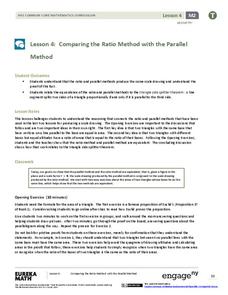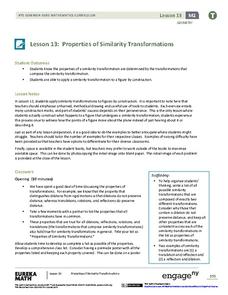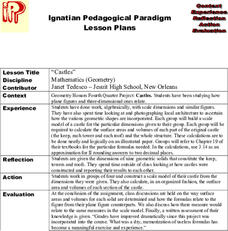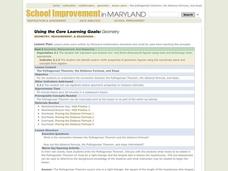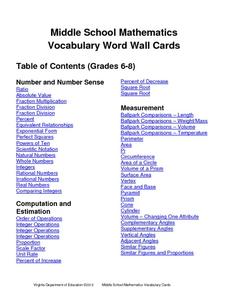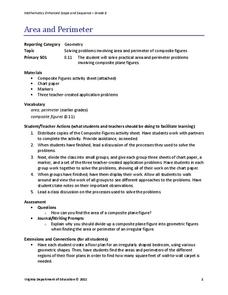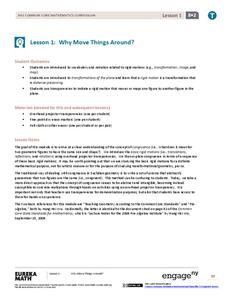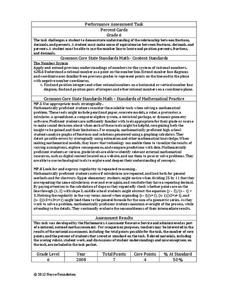EngageNY
Comparing the Ratio Method with the Parallel Method
Can you prove it? Lead your class through the development of the Side Splitter Theorem through proofs. Individuals connect the ratio and parallel method of dilation through an exploration of two proofs. After completing the proofs,...
EngageNY
Properties of Similarity Transformations
You can explain it, but can you do it? After learners view a sequence of transformations, the next logical step is creating the transformation. Challenge your classes to construct a composition of transformations and verify the...
EngageNY
Properties of Area
What properties does area possess? Solidify the area properties that pupils learned in previous years. Groups investigate the five properties using four problems, which then provide the basis for a class discussion.
EngageNY
Construct a Square and a Nine-Point Circle
Anyone can draw a square, but can you CONSTRUCT a square? Here is a resource that challenges math scholars to create steps to finish their own construction. They test their ability to read and follow directions to complete a construction...
Curated OER
Castles
Young scholars create a scale model to a castle using the dimensions they were given. They calculate the surface areas and volumes of each section of their castle.
Curated OER
Standard Treehouse Lesson Plan
Seventh graders investigate the concepts related to the geometry of treehouses that focuses on angles that are similar and congruent. They conduct class discussion in terms of looking at three dimensional shapes that are represented in...
Curated OER
Parabola
In this parabolas worksheet, 10th graders solve and graph 12 different problems related to various types of parabolas. First, they determine the vertex and the y-intercept based on the graph illustrated for each. Then, students write a...
Curated OER
System of Axes
In this system of axes worksheet, 10th graders solve and complete 1 word problem. First, they determine the figure shown in the illustration and set-up an expression. Then, students solve to find the shaded region of the diagram.
Curated OER
NUMB3RS Activity: Regular Ploygon Centroids
Students investigate geo-profiling. For this secondary mathematics lesson, students use geo-profiling to determine the most probable location of a criminal. Students find the centroid of a polygon where the vertices represent...
Curated OER
Challenge: Skills and Applications Lesson 1.3
In this skills instructional activity, learners explain the Segment Addition Postulate, provide examples and counter examples and determine congruent line segments. This one-page instructional activity contains 11 multi-step problems.
Curated OER
THE TRIANGLE INEQUALITY IN ANIMATION
Students open up the script to generate the sketch. They examine the viewing of the animation of a triangle. Students incorporate writing skills across the curriculum within this lesson.
Curated OER
Exploring the Slopes of Parallel and Perpendicular Lines
Students calculate the slope of parallel and perpendicular lines.In this algebra lesson, students differentiate between parallel and perpendicular lines. They graph their lines using the slope of the equation.
Curated OER
Reflections over Two Lines & Dilations
Students create reflections over two lines. For this reflections worksheet, students compare and contrast reflections over parallel and intersecting lines. They dilate figures and investigate the effect of the dilation using measurement...
Curated OER
The Pythagorean Theorem, the Distance Formula, and Slope
Learners explore the concept of the Pythagorean Theorem. In this Pythagorean Theorem lesson, students derive the distance formula and slope of a line from the Pythagorean Theorem.
Curated OER
Conic Sections and Locii
Students differentiate between ellipse and hyperbola. In this algebra instructional activity, students graph and solve elliptical equations. They use the cabri program to create the different conics and move them around.
Curated OER
Fifteen Regents Exam Midpoint Problems
In this midpoint learning exercise, learners answer ten multiple choice and five free-response problems using the midpoint formula. The solutions are provided.
Curated OER
It's Not All Greek to Me
Learners find out the meaning for prefixes used in math vocabulary. By dissecting words used in everyday math, they figure out what the prefix indicates and what the word means. A variety of well-organized worksheets and activities...
Virginia Department of Education
Middle School Mathematics Vocabulary Word Wall Cards
Having a good working knowledge of math vocabulary is so important for learners as they progress through different levels of mathematical learning. Here is 125 pages worth of wonderfully constructed vocabulary and concept review cards....
Dick Blick Art Materials
Start with a Circle...
The Golden Ratio. The Divine Proportion. Yup. It's math and art blended into one colorful activity. Young artists combine colored tissue paper circles and parts of circles to create geometric patterns. As a bonus, kids get to figure out...
Shodor Education Foundation
Pythagorean Theorem
Most adults remember learning about the Pythagorean theorem, but they don't all remember how to use it. The emphasis here is on developing an intuitive understanding of how and when to use the theorem. Young mathematicians explore...
Shodor Education Foundation
Sets and the Venn Diagram (Beginner)
Venn diagrams are helpful in understanding the idea of a set and using attributes to sort items. This basic plan is an introduction with an added bonus of an applet that can be used to demonstrate the activity. If a classroom of...
Virginia Department of Education
Area and Perimeter
Develop a strategy for finding the area and perimeter of irregular figures. Building on an understanding of finding area and perimeter of rectangles and triangles, learners apply the same concepts to composite figures. After...
EngageNY
Why Move Things Around?
Explore rigid motion transformations using transparency paper. Learners examine a series of figures and describe the transformations used to create the series. They then use transparency paper to verify their conclusions.
Noyce Foundation
Percent Cards
Explore different representations of numbers. Scholars convert between fractions, decimals, and percents, and then use these conversions to plot the values on a horizontal number line.
Other popular searches
- Coordinate Plane Geometry
- Plane Geometry Symmetry
- Point Line Plane Geometry
- Plane Geometry Shapes
- Plane Geometry Second Grade
- Plane Geometry and Theorems
- Plane Geometry Area
- Plane Geometry Symmetry 3d
- Plane Geometry Twelve
- Plane Geometry Middle Point
- Plane Geometry Symmetry 3
- Geometry Coordinate Graph


